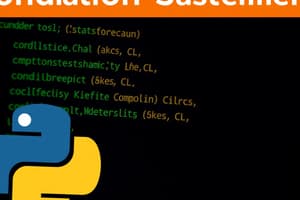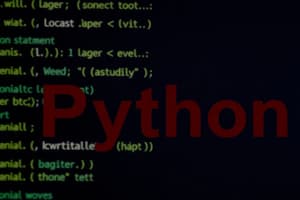Podcast
Questions and Answers
In Python, which of the following is true regarding conditional statements?
In Python, which of the following is true regarding conditional statements?
- They define functions within a program.
- They are primarily used for mathematical computations.
- They execute code blocks based on whether a condition is true or false. (correct)
- They are optional and do not affect the program's logic.
How does Python determine the scope of the code within an if statement?
How does Python determine the scope of the code within an if statement?
- By using curly brackets `{}`.
- By using parenthesis `()`.
- By using the `scope` keyword.
- By using indentation alone. (correct)
What happens if an if statement in Python is written without proper indentation?
What happens if an if statement in Python is written without proper indentation?
- The code will execute but may produce unexpected results.
- Python will raise an `IndentationError`. (correct)
- The program will execute by ignoring the `if` statement altogether.
- The interpreter will automatically correct the indentation.
In Python, what does the elif statement do?
In Python, what does the elif statement do?
Consider the following code snippet:
x = 5
y = 10
if x > y:
print("x is greater than y")
elif x < y:
print("x is less than y")
else:
print("x and y are equal")
What will be the output of this code?
Consider the following code snippet:
x = 5
y = 10
if x > y:
print("x is greater than y")
elif x < y:
print("x is less than y")
else:
print("x and y are equal")
What will be the output of this code?
What is a 'nested if statement' in Python?
What is a 'nested if statement' in Python?
In Python, which comparison operator checks for equality?
In Python, which comparison operator checks for equality?
Which of the following code snippets correctly demonstrates the use of an else statement in Python?
Which of the following code snippets correctly demonstrates the use of an else statement in Python?
What will be the output of the following Python code?
age = 25
if age > 18:
if age > 21:
print("Eligible to drink alcohol")
else:
print("Not eligible to drink alcohol")
else:
print("Too young")
What will be the output of the following Python code?
age = 25
if age > 18:
if age > 21:
print("Eligible to drink alcohol")
else:
print("Not eligible to drink alcohol")
else:
print("Too young")
Consider the following code:
x = 10
y = 5
if x == y:
print("Equal")
elif x != y:
if x > y:
print("x is greater")
else:
print("y is greater")
What will be printed?
Consider the following code:
x = 10
y = 5
if x == y:
print("Equal")
elif x != y:
if x > y:
print("x is greater")
else:
print("y is greater")
What will be printed?
Which logical condition is used in Python to determine if a number is within a specific range (e.g., between 10 and 20, inclusive)?
Which logical condition is used in Python to determine if a number is within a specific range (e.g., between 10 and 20, inclusive)?
What is the primary purpose of using conditional statements in programming?
What is the primary purpose of using conditional statements in programming?
How does the else statement differ from the elif statement in Python?
How does the else statement differ from the elif statement in Python?
Predict the output of the following Python code:
x = 7
y = 7
if x > y:
print("x is greater than y")
elif x < y:
print("x is less than y")
else:
print("x is equal to y")
Predict the output of the following Python code:
x = 7
y = 7
if x > y:
print("x is greater than y")
elif x < y:
print("x is less than y")
else:
print("x is equal to y")
In the context of Python conditional statements, what is indentation primarily used for?
In the context of Python conditional statements, what is indentation primarily used for?
Given the following Python code snippet:
value = 50
if value > 100:
print("Greater than 100")
elif value > 50:
print("Greater than 50")
else:
print("Less than or equal to 50")
What will be the output?
Given the following Python code snippet:
value = 50
if value > 100:
print("Greater than 100")
elif value > 50:
print("Greater than 50")
else:
print("Less than or equal to 50")
What will be the output?
If a Python if statement has multiple elif conditions, how are these conditions evaluated?
If a Python if statement has multiple elif conditions, how are these conditions evaluated?
What is the outcome of the following Python code if age is 15?
age = 15
if age > 18:
print("Adult")
else:
if age > 12:
print("Teenager")
else:
print("Child")
What is the outcome of the following Python code if age is 15?
age = 15
if age > 18:
print("Adult")
else:
if age > 12:
print("Teenager")
else:
print("Child")
How do you check if a variable x is not equal to a value y in Python?
How do you check if a variable x is not equal to a value y in Python?
What is the significance of the order of conditions in a Python if-elif-else construct?
What is the significance of the order of conditions in a Python if-elif-else construct?
Analyze the following Python code and determine its output:
a = 5
b = 10
if a > b:
print("a is greater than b")
elif a == b:
print("a is equal to b")
else:
if a < b:
print("a is less than b")
else:
print("This will not be printed")
Analyze the following Python code and determine its output:
a = 5
b = 10
if a > b:
print("a is greater than b")
elif a == b:
print("a is equal to b")
else:
if a < b:
print("a is less than b")
else:
print("This will not be printed")
In Python, what happens if you have an else statement without a preceding if statement?
In Python, what happens if you have an else statement without a preceding if statement?
Consider the code:
x = 10
if x > 5:
print("A")
if x > 7:
print("B")
else:
print("C")
What is the output?
Consider the code:
x = 10
if x > 5:
print("A")
if x > 7:
print("B")
else:
print("C")
What is the output?
How does Python handle multiple conditions when using chained comparison operators such as a < b < c?
How does Python handle multiple conditions when using chained comparison operators such as a < b < c?
What would happen if you accidentally wrote if x = 5: instead of if x == 5: in Python?
What would happen if you accidentally wrote if x = 5: instead of if x == 5: in Python?
Suppose you need to check if a variable num is divisible by both 2 and 3. Which of the following Python conditions is most efficient?
Suppose you need to check if a variable num is divisible by both 2 and 3. Which of the following Python conditions is most efficient?
Given the following code, what is the output?
x = True
y = False
if x and y:
print("Both true")
elif x or y:
print("One is true")
else:
print("None is true")
Given the following code, what is the output?
x = True
y = False
if x and y:
print("Both true")
elif x or y:
print("One is true")
else:
print("None is true")
What is the most accurate way to describe the relationship between if, elif, and else statements in Python?
What is the most accurate way to describe the relationship between if, elif, and else statements in Python?
What constraints apply regarding the data type of the expression used in an if or elif statement in Python?
What constraints apply regarding the data type of the expression used in an if or elif statement in Python?
Flashcards
Conditional Statements
Conditional Statements
Statements that execute different actions based on specified conditions.
If Statement
If Statement
Specifies a block of code to be executed if a specified condition is true.
Else Statement
Else Statement
Specifies a block of code to be executed if the same condition is false.
Elif Statement
Elif Statement
Signup and view all the flashcards
Equals (==)
Equals (==)
Signup and view all the flashcards
Not Equals (!=)
Not Equals (!=)
Signup and view all the flashcards
Less Than (<)
Less Than (<)
Signup and view all the flashcards
Less Than or Equal To (<=)
Less Than or Equal To (<=)
Signup and view all the flashcards
Greater Than (>)
Greater Than (>)
Signup and view all the flashcards
Greater Than or Equal To (>=)
Greater Than or Equal To (>=)
Signup and view all the flashcards
Indentation in Python
Indentation in Python
Signup and view all the flashcards
Nested If Statement
Nested If Statement
Signup and view all the flashcards
Study Notes
Conditional Statements
- Used to perform different actions based on different conditions.
- Allows performing different actions for different decisions in code.
- Achieved in code using conditional statements.
Types of Conditional Statements in Python
if: Executes a block of code if a specified condition is true.else: Executes a block of code if the specified condition is false.elif: Specifies a new condition to test if the first condition is false.
Python Conditions and If Statements
- Python supports standard logical conditions from mathematics to be used in "if statements" and loops.
- Equals:
a == b - Not Equals:
a != b - Less than:
a < b - Less than or equal to:
a <= b - Greater than:
a > b - Greater than or equal to:
a >= b
Examples of Python conditions
- Variables
a(33) andb(200) can be used to test ifbis greater thana. - The condition
b > aevaluates to true, it prints "b is greater than a" to the screen.
Indentation
- Python uses indentation (whitespace at the beginning of a line) to define scope in the code.
- Omitting indentation in
ifstatements raises an error.
The if Statement
- Used to execute a block of Python code if a condition is true.
- Syntax:
if <EXPRESSION> : # if block of statements
The else Statement
- Used to execute a block of code if the condition is false.
- Syntax:
if <EXPRESSION>: # if block of statements else: # else block of statements
The Nested if Statement
- Allows using
ifstatements inside otherifstatements. - Syntax:
if <EXPRESSION>: # if block of statements if <EXPRESSION>: # if block of statements else: # elif block of statements - Example:
age = 13 if age > 10: print("Above 10") if age > 20: print("and also above 20") else: print("but not above 20")
The elif Statement
- Specifies a new condition to test if the first condition is false.
- Syntax:
if <EXPRESSION>: # if block of statements elif <EXPRESSION>: # elif block of statements else: # else block of statements - Example:
time = 15 if time < 10: greeting = "Good morning" elif time < 20: greeting = "Good day" else: greeting = "Good evening"
Examples of if Statements
- Example:
x, y = 10, 20 if x == y: print("x and y are equal.") if x < y: print("x is less than y.") if x > y: # If there is only one line of statement to be executed, curly brackets ({}) can be omitted print("x is greater than y.")
Examples of else Statement
- Example:
x = 200 if x < 100: print("It is less than 100.") else: print("It is greater than or equal to 100.")
Examples of else Statement and remainders
- Checks if a number is even or odd based on the remainder when divided by 2.
- Example:
a = 200 # If the remainder when a is divided by 2 is 0, it is even, otherwise, it is odd. if a % 2 == 0: # if division remainder is 0, a is even print("a is even.") else: # if (a % 2 != 0), if division remainder is not 0, a is odd print("a is odd.")
Examples of Nested if Statement
- Example where an if x < y statement is only evaluated if x != y:
x, y = 10, 20 if x == y: print("x and y are equal.") else: # x != y if x < y: print("x is less than y.") else: print("x is greater than y.")
Examples of elif Statement
- Example:
x, y = 10, 20 if x == y: print("x and y are equal.") elif x < y: # (x != y) and (x < y) print("x is less than y.") else: # (x != y) and (x > y) print("x is greater than y.")
Studying That Suits You
Use AI to generate personalized quizzes and flashcards to suit your learning preferences.





